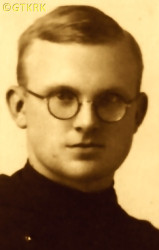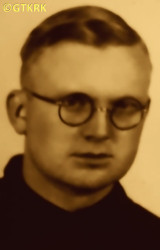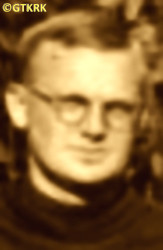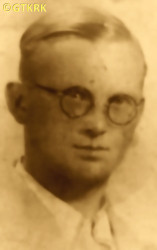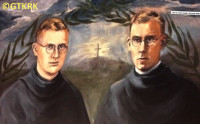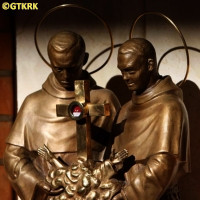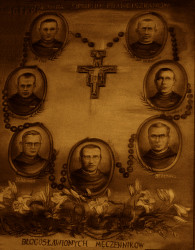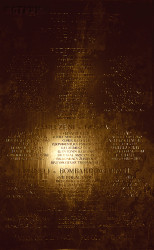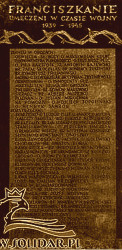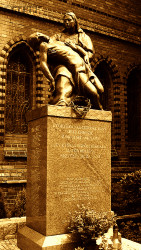Roman Catholic
St Sigismund parish
05-507 Słomczyn
85 Wiślana Str.
Konstancin deanery
Warsaw archdiocese, Poland
full list:
displayClick to display full list

searchClick to search full list by categories
wyświetlKliknij by wyświetlić pełną listę po polsku

szukajKliknij by przeszukać listę wg kategorii po polsku

Martyrology of the clergy — Poland
XX century (1914 – 1989)
personal data
religious status
blessed
surname
STĘPIEŃ
forename(s)
Charles (pl. Karol)
religious forename(s)
Herman
beatification date
13.06.1999more on
www.swzygmunt.knc.pl
[access: 2013.05.19]

the RC Pope John Paul IImore on
en.wikipedia.org
[access: 2014.09.21]
function
religious cleric
creed
Latin (Roman Catholic) Church RCmore on
en.wikipedia.org
[access: 2014.09.21]
congregation
Order of Friars Minor Conventual OFMConvmore on
en.wikipedia.org
[access: 2013.05.19]
(i.e. Conventual Franciscans)
diocese / province
st Anthony of Padua and bl. James Strzemię province OFMConvmore on
pl.wikipedia.org
[access: 2014.08.18]
academic distinctions
Theology MA
date and place
of death
19.07.1943

Borovikovshchinatoday: Ivyanets ssov., Valozhyn dist., Minsk reg., Belarus
more on
be.wikipedia.org
[access: 2022.08.05]
details of death
After German and Russian invasion of Poland in 09.1939 and start of the World War II, after start of Russian occupation helped and supported Poles deported by the Russians to Russia and Siberia.
After German attack on 22.06.1941 of their erstwhile ally, Russians, and start of German occupation, during German Germ. „Operation Hermann” retaliatory action, being the German response to Polish armed resistance (part of Polish Clandestine State activities), during German pacification of the Pierszaje parish village, c. 20 km north of Ivyanets, all inhabitants were arrested.
Together with his parish priest, co‐friar Fr Achilles Joseph Puchała, driven out and murdered in a nearby village, c. 9 km north from Ivyanets — prob. being earlier brutally tortured (were to have their eyes gauged out, tongues torn out, noses, ears and hands cut off and finally go bound with a wire), then shot (both into the head, one from the back, the other from front) and finally burnt in a shed.
A couple of German were to dress in bloodied Franciscan cassocks and after return to the village blasphemously imitate the rites of the Holy Mass.
cause of death
mass murder
perpetrators
Germans
sites and events
Operation „Hermann”Click to display the description, Deportations to SiberiaClick to display the description, Ribbentrop‐MolotovClick to display the description, Pius XI's encyclicalsClick to display the description
date and place
of birth
21.10.1910Birth certification on:
metryki.genealodzy.pl
[access: 2025.03.01]

Łódźtoday: Łódź city pov., Łódź voiv., Poland
more on
en.wikipedia.org
[access: 2021.07.18]
parents
STĘPIEŃ Joseph
🞲 ?, ? — 🕆 ?, ?

PUCH Marianne
🞲 ?, ? — 🕆 ?, ?
baptism
09.11.1910Birth certification on:
metryki.genealodzy.pl
[access: 2025.03.01]

Łódźtoday: Łódź city pov., Łódź voiv., Poland
more on
en.wikipedia.org
[access: 2021.07.18]
Exaltation of the Holy Cross RC church
religious vows
03.09.1930 (temporary)
27.06.1934 (permanent)
presbyter (holy orders)
ordination
25.07.1937

Rometoday: Rome prov., Lazio reg., Italy
more on
en.wikipedia.org
[access: 2021.12.18]
positions held
1940 – 1943
vicar — Pyarshaitoday: Pyarshai ssov., Valozhyn dist., Minsk reg., Belarus
more on
be.wikipedia.org
[access: 2022.10.26] ⋄ St Michael the Archangel monastery (in Ivyanets), Conventual Franciscans OFMConv ⋄ St George the Martyr RC parish
from 1939
friar — Ivyanetstoday: Valozhyn dist., Minsk reg., Belarus
more on
en.wikipedia.org
[access: 2020.12.11] ⋄ St Michael the Archangel monastery, Conventual Franciscans OFMConv
1939
friar — Vilniustoday: Vilnius city dist., Vilnius Cou., Lithuania
more on
en.wikipedia.org
[access: 2022.01.06] ⋄ Assumption of the Blessed Virgin Mary monastery, Conventual Franciscans OFMConv
till 1939
student — Lvivtoday: Lviv urban hrom., Lviv rai., Lviv obl., Ukraine
more on
en.wikipedia.org
[access: 2022.01.16] ⋄ theology, Department of Theology, John Casimir University [i.e. clandestine John Casimir University (1941‐1944) / Ivan Franko University (1940‐1941) / John Casimir University (1919‐1939) / Franciscan University (1817‐1918)] — Master's thesis „Body culture and Christian ethics” (conferment on 27.06.1939)
1938 – 1939
friar — Radomskotoday: Radomsko gm., Radomsko pov., Łódź voiv., Poland
more on
en.wikipedia.org
[access: 2021.12.18] ⋄ Exaltation of the Holy Cross monastery, Conventual Franciscans OFMConv — monastery librarian and treasury officer / procurator, prefect of two elementary schools
1934 – 1938
student — Rometoday: Rome prov., Lazio reg., Italy
more on
en.wikipedia.org
[access: 2021.12.18] ⋄ philosophy and theology, St Bonaventure Bishop and Confessor „Seraphicum” [i.e. Pontifical Faculty of Theology (from 1955), Pontifical College (1935‐1955), College (till 1935)], Conventual Franciscans OFMConv
1933 – 1934
student — Krakówtoday: Kraków city pov., Lesser Poland voiv., Poland
more on
en.wikipedia.org
[access: 2021.06.07] ⋄ Philosophical and Theological Studies, St Francis of Assisi monastery, Conventual Franciscans OFMConv
c. 1933
student — Lvivtoday: Lviv urban hrom., Lviv rai., Lviv obl., Ukraine
more on
en.wikipedia.org
[access: 2022.01.16] ⋄ Philosophical Study (higher theological seminary), Immaculate Conception of the Blessed Virgin Mary monastery, Conventual Franciscans OFMConv
1930 – 1933
friar — Lvivtoday: Lviv urban hrom., Lviv rai., Lviv obl., Ukraine
more on
en.wikipedia.org
[access: 2022.01.16] ⋄ Immaculate Conception of the Blessed Virgin Mary monastery, Conventual Franciscans OFMConv — student of the last grades of the Minor Theological Seminary (gymnasium), culminating with matura exam
02.09.1929 – 03.09.1930
novitiate — Łagiewnikitoday: neighborhood in Łódź city, Łódź city pov., Łódź voiv., Poland
more on
en.wikipedia.org
[access: 2021.07.18] ⋄ St Anthony of Padua and St John the Baptist monastery, Conventual Franciscans OFMConv
till 1929
pupil — Lvivtoday: Lviv urban hrom., Lviv rai., Lviv obl., Ukraine
more on
en.wikipedia.org
[access: 2022.01.16] ⋄ Minor Theological Seminary (gymnasium) at the Immaculate Conception of the Blessed Virgin Mary monastery, Conventual Franciscans OFMConv
others related
in death
PUCHAŁAClick to display biography Joseph (Fr Achilles)
sites and events
descriptions
Operation „Hermann”: On 19.06.1943 a unit of Polish resistance Home Army AK (part of Polish Clandestine State) from Stowbtsy in Belarus attacked Ivyanets. The town was captured — in history this act is known as „Ivyanets insurgency” — and German garrison defeated. All prisoners were released, among them a dozen or so Jews, including a few physicians. C. 40‐150 Germans and their collaborators were executed. C. 100‐200 functionaries of Belarusian support police, collaborating with Germans, voluntarily joined the partisan unit. After 18 hours partisans left Ivyanets and moved towards nearby Nalibocka Forest. In retaliation Germans immediately murdered c. 150 inhabitants of Ivyanets and organized a wide ranging anti‐partisan operation known under its codename „Hermann”. The main aim was elimination of partisan units — Polish and Russian — operating in Nalibocka Forest. It started on 13.07.1943. C. 9,000 Germans and its collaborators — including Russians — participated supported by airplanes, artillery and heavy weaponry. Around the forest Germans set up a strip of „scorched earth”, c. 10‐15 km wide. During operation Germans burnt to ground more than 60 Polish and Belarus villages and murdered c. 4,280 civilians including a few Catholic priests — those regarded as supporting the partisans were executed, hanged, burnt alive. C. 21,000‐25,000 civilians were sent to 3rd Reich, i.e. Germany, for slave labour, and thousands — including elderly, women and children — were evicted beyond the blockade strip. Partisans however — both Polish and Russians — managed to break of the encirclement, despite huge losses. One of the towns in the vicinity of the region under operation — c. 20 km from Nalibocka Forest — was Nowogródek. During the operation Germans arrested there c. 120 its inhabitants and regarded as hostages. Local Sisters of the Holy Family of Nazareth nuns — in Nowogródek since 04.09.1929, providing religious education and instruction to children and youth — stood up in their defense. 11 of them were arrested by the Germans and murdered. (more on: en.wikipedia.orgClick to attempt to display webpage
[access: 2018.10.04])
Deportations to Siberia: In 1939‐1941 Russians deported — in four large groups in: 10.02.1940, 13‐14.04.1940, 05‐07.1940, 05‐06.1941 — up to 1 mln of Polish citizens from Russian occupied Poland to Siberia leaving them without any support at the place of exile. Thousands of them perished or never returned. The deportations east, deep into Russia, to Siberia resumed after 1944 when Russians took over Poland. (more on: en.wikipedia.orgClick to attempt to display webpage
[access: 2014.09.21])
Ribbentrop‐Molotov: Genocidal Russian‐German alliance pact between Russian leader Joseph Stalin and German leader Adolf Hitler signed on 23.08.1939 in Moscow by respective foreign ministers, Mr. Vyacheslav Molotov for Russia and Joachim von Ribbentrop for Germany. The pact sanctioned and was the direct cause of joint Russian and German invasion of Poland and the outbreak of the World War II in 09.1939. In a political sense, the pact was an attempt to restore the status quo ante before 1914, with one exception, namely the „commercial” exchange of the so‐called „Kingdom of Poland”, which in 1914 was part of the Russian Empire, fore Eastern Galicia (today's western Ukraine), in 1914 belonging to the Austro‐Hungarian Empire. Galicia, including Lviv, was to be taken over by the Russians, the „Kingdom of Poland” — under the name of the General Governorate — Germany. The resultant „war was one of the greatest calamities and dramas of humanity in history, for two atheistic and anti‐Christian ideologies — national and international socialism — rejected God and His fifth Decalogue commandment: Thou shall not kill!” (Abp Stanislav Gądecki, 01.09.2019). The decisions taken — backed up by the betrayal of the formal allies of Poland, France and Germany, which on 12.09.1939, at a joint conference in Abbeville, decided not to provide aid to attacked Poland and not to take military action against Germany (a clear breach of treaty obligations with Poland) — were on 28.09.1939 slightly altered and made more precise when a treaty on „German‐Russian boundaries and friendship” was agreed by the same murderous signatories. One of its findings was establishment of spheres of influence in Central and Eastern Europe and in consequence IV partition of Poland. In one of its secret annexes agreed, that: „the Signatories will not tolerate on its respective territories any Polish propaganda that affects the territory of the other Side. On their respective territories they will suppress all such propaganda and inform each other of the measures taken to accomplish it”. The agreements resulted in a series of meeting between two genocidal organization representing both sides — German Gestapo and Russian NKVD when coordination of efforts to exterminate Polish intelligentsia and Polish leading classes (in Germany called «Intelligenzaktion», in Russia took the form of Katyń massacres) where discussed. Resulted in deaths of hundreds of thousands of Polish intelligentsia, including thousands of priests presented here, and tens of millions of ordinary people,. The results of this Russian‐German pact lasted till 1989 and are still in evidence even today. (more on: en.wikipedia.orgClick to attempt to display webpage
[access: 2015.09.30])
Pius XI's encyclicals: Facing the creation of two totalitarian systems in Europe, which seemed to compete with each other, though there were more similarities than contradictions between them, Pope Pius XI issued in 03.1937 (within 5 days) two encyclicals. In the „Mit brennender Sorge” (Eng. „With Burning Concern”) published on 14.03.1938, condemned the national socialism prevailing in Germany. The Pope wrote: „Whoever, following the old Germanic‐pre‐Christian beliefs, puts various impersonal fate in the place of a personal God, denies the wisdom of God and Providence […], whoever exalts earthly values: race or nation, or state, or state system, representatives of state power or other fundamental values of human society, […] and makes them the highest standard of all values, including religious ones, and idolizes them, this one […] is far from true faith in God and from a worldview corresponding to such faith”. On 19.03.1937, published „Divini Redemptoris” (Eng. „Divine Redeemer”), in which criticized Russian communism, dialectical materialism and the class struggle theory. The Pope wrote: „Communism deprives man of freedom, and therefore the spiritual basis of all life norms. It deprives the human person of all his dignity and any moral support with which he could resist the onslaught of blind passions […] This is the new gospel that Bolshevik and godless communism preaches as a message of salvation and redemption of humanity”… Pius XI demanded that the established human law be subjected to the natural law of God , recommended the implementation of the ideal of a Christian state and society, and called on Catholics to resist. Two years later, National Socialist Germany and Communist Russia came together and started World War II. (more on: www.vatican.vaClick to attempt to display webpage
[access: 2023.05.28], www.vatican.vaClick to attempt to display webpage
[access: 2023.05.28])
sources
personal:
swzygmunt.knc.plClick to attempt to display webpage
[access: 2012.11.23], metryki.genealodzy.plClick to attempt to display webpage
[access: 2025.03.01]
bibliographical:
„Biographical–bibliographical dictionary of Polish Conventual Franciscan Fathers murdered and tragically dead in 1939‐1945”, Lukas Janecki, Franciscan Fathers’ Publishing House, Niepokalanów, 2016
original images:
prawy.plClick to attempt to display webpage
[access: 2019.04.16], www.youtube.comClick to attempt to display webpage
[access: 2019.04.16], rzgowska.franciszkanie-warszawa.plClick to attempt to display webpage
[access: 2019.04.16], rzgowska.franciszkanie-warszawa.plClick to attempt to display webpage
[access: 2019.04.16], www2.ofmconv.pcn.netClick to attempt to display webpage
[access: 2019.04.16], www2.ofmconv.pcn.netClick to attempt to display webpage
[access: 2019.04.16], www.sowiniec.com.plClick to attempt to display webpage
[access: 2014.07.11], www.szczecin.plClick to attempt to display webpage
[access: 2014.09.21]
LETTER to CUSTODIAN/ADMINISTRATOR
If you have an Email client on your communicator/computer — such as Mozilla Thunderbird, Windows Mail or Microsoft Outlook, described at WikipediaPatrz:
en.wikipedia.org, among others — try the link below, please:
LETTER to CUSTODIAN/ADMINISTRATORClick and try to call your own Email client
If however you do not run such a client or the above link is not active please send an email to the Custodian/Administrator using your account — in your customary email/correspondence engine — at the following address:

giving the following as the subject:
MARTYROLOGY: STĘPIEŃ Charles
To return to the biography press below:
 Click to return to biography
Click to return to biography








